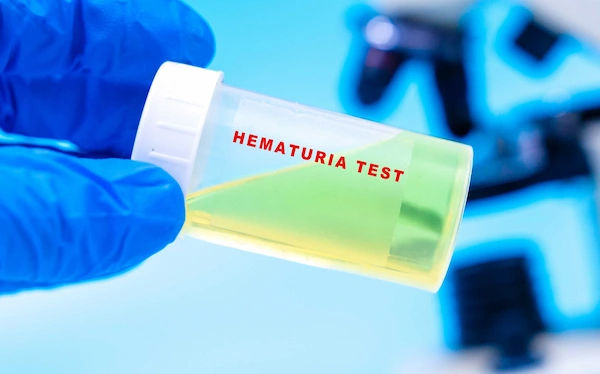Guide to Blood Urine Could Be Kidney Cancer
Understand the serious implications of seeing blood in your urine (hematuria), a primary warning sign for kidney cancer. Learn about diagnosis, risk factors, and when to consult a specialist.


Introduction
Seeing blood in urine can be alarming. Sometimes it’s obvious—your urine looks pink, red, or cola-colored. Other times, only a lab test finds microscopic blood. Either way, hematuria deserves attention because while many causes are benign (such as a urinary tract infection or kidney stones), blood in urine can also be an early sign of a serious problem, including kidney cancer. The good news: most people with blood in urine do not have cancer, but it’s vital to know when to act and what tests make sense.
In this guide, we’ll explain what hematuria is, how to tell gross from microscopic bleeding, and which symptoms are red flags. We’ll unpack the most common non-cancer causes, then explore when blood in urine could point to kidney cancer and how doctors figure it out. You’ll learn about key tests—urinalysis, cystoscopy, ultrasound, and CT urogram—plus practical steps to take now, from hydration to preparing for your appointment. We’ll also tackle myths, share expert-backed statistics, and highlight when to consult a doctor. If symptoms persist beyond two weeks, consult a doctor online with Apollo 24|7 for further evaluation. Let’s make a scary moment more manageable—with clear steps and reliable information.
Understanding Hematuria (Blood in Urine)
Hematuria simply means blood in urine. It appears in two broad forms. Gross hematuria is visible to the eye; the urine looks pink, red, or brown. Microscopic hematuria is invisible; a lab detects red blood cells (RBCs) on microscopy—defined in guidelines as three or more RBCs per high-power field (≥3 RBC/HPF) on a properly collected specimen [1]. Because dipsticks can give false positives (for example, myoglobin from muscle injury), confirmation with microscopy is important.
• Color can hint at the cause: bright-red urine suggests fresher bleeding from the lower urinary tract; tea- or cola-colored urine could occur with older blood or glomerular (kidney filter) disease. Clots often come from the bladder or lower tract. Conversely, “foamy” urine with blood and protein may point to a filter (glomerular) problem rather than a structural tumor.
Food and medication “look-alikes” complicate the picture. Beets, blackberries, and food dyes can temporarily color urine red (beeturia). Certain drugs (phenazopyridine, rifampin) and vitamin C can alter urine color or interfere with testing. Menstrual blood can contaminate samples; midstream, clean-catch urines minimize this. Long-tail terms to know include “gross hematuria causes” and “microscopic hematuria evaluation”—concepts that shape next steps. The bottom line: if your urine looks red or a test found blood, it’s worth a systematic look to find the source.Consult a Top General Physician
Gross vs. microscopic hematuria
• Gross hematuria: visible blood; higher short-term cancer yield, especially in older adults and smokers.
• Microscopic hematuria: often discovered incidentally; cancer risk is lower but nonzero, and risk stratification guides workup.
What different urine colors can mean (red, tea, cola)?
• Red/pink: fresh blood, beeturia, dyes.
• Cola/tea: older blood, glomerular disease, myoglobin/hemoglobin.
• Orange: dehydration or medications (e.g., phenazopyridine).
Foods, meds, and other look-alikes that mimic blood
• Beeturia, rhubarb, blackberries.
• Rifampin, phenazopyridine, some laxatives, and vitamin C affecting tests [3][5].
Could Blood in Urine Mean Cancer?
Most people with blood in urine do not have cancer, but hematuria is one of the most important warning signs for tumors of the kidney, ureter, or bladder. Painless visible blood in urine in adults warrants prompt evaluation because it carries a higher chance of a serious cause compared with microscopic hematuria [4][5].
How often is cancer the cause? Estimates vary by age, sex, and smoking history. In modern risk-based approaches, the overall malignancy rate in microscopic hematuria is around 1%—higher in older adults and those who smoke—and for visible blood, the risk can be several-fold higher (roughly 10% or more in certain higher-risk groups) [1][4][5]. Bladder cancer is often the most frequent malignancy found in hematuria workups, followed by kidney and upper urinary tract cancers.
“Kidney cancer symptoms in adults” often include hematuria, flank pain, or a palpable mass, but many kidney tumors are found incidentally on imaging for other reasons [2][6]. The presence of a clot, persistent painless bleeding, or recurrence after a treated UTI increases suspicion. Unique insight: anticoagulant use (e.g., warfarin, DOACs) doesn’t cause cancer, but it can unmask bleeding from an underlying lesion. So even if you’re on blood thinners, visible blood in urine needs evaluation rather than attribution to medication alone. If your urine turns red and you have risk factors like age over 45 or smoking, seek medical advice promptly. If symptoms persist beyond two weeks, consult a doctor online with Apollo 24|7 for further evaluation.
How often is cancer the cause?
• Microscopic hematuria: about 1% overall (higher with age/smoking) [1].
• Visible hematuria: risk increases substantially; age 45+ triggers urgent evaluation in many guidelines [4][5].
Kidney vs bladder vs upper tract causes
• Bladder cancer frequently presents with painless visible hematuria [4][5].
• Kidney (renal cell) cancer can bleed into the collecting system; sometimes accompanied by flank pain or mass [2][6].
• Upper tract urothelial carcinoma (ureter/renal pelvis) is less common but important, especially in smokers.
Common Non-Cancer Causes of Blood in Urine
The majority of hematuria cases stem from non-cancer causes. UTIs (cystitis, pyelonephritis) commonly cause micro or gross hematuria with burning urination, urgency, and frequency. A “microscopic hematuria evaluation” often starts with a urinalysis and urine culture to identify infection. When infection is treated, your clinician may recheck the urine to confirm the blood has resolved.
Kidney stones (nephrolithiasis) are another leading cause—often producing dull or cramping flank pain radiating to groin, nausea, and variable bleeding. Strenuous exercise can trigger “exercise-induced hematuria,” usually transient and benign. In men with benign prostatic hyperplasia (BPH), fragile surface blood vessels can bleed.
Glomerular diseases (e.g., IgA nephropathy) originate in the kidney filters and may show protein and blood in urine together, sometimes with high blood pressure and swelling. Dysmorphic RBCs on microscopy or RBC casts point to a glomerular source and shift the workup toward nephrology rather than urologic imaging [3]. Menstrual contamination can cause a false alarm; use midstream clean-catch collection.
Unique perspective: If hematuria occurs with fever, dysuria, or urgency, your clinician may treat a UTI first and then retest. If blood persists, the workup proceeds as if there is no infection to avoid missing a tumor hiding behind inflammation. Avoid self-diagnosing; both “kidney stones vs cancer” and “UTI vs cancer” can look similar initially. If your condition does not improve after trying these methods, book a physical visit to a doctor with Apollo 24|7.
Urinary tract infection and inflammation
• Symptoms: burning, urgency, frequency, suprapubic pain; blood can be present.
• Follow-up urinalysis after treatment is important to document resolution [3][5].
Kidney stones and vigorous exercise
• Colicky flank pain + hematuria suggests stones; CT or ultrasound can help.
• Exercise-induced hematuria should resolve within 48–72 hours of rest.
Glomerular disease, BPH, and menstrual contamination
• Protein + blood suggests glomerular origin.
• BPH-related bleeding often occurs in older men.
Menstrual blood can contaminate samples—collect carefully.
When to Worry: Red Flags and Risk Factors
The most concerning scenario is painless visible blood in urine, particularly in adults over 45, smokers, or those with occupational exposures (aromatic amines in dyes/rubber industries). Guidelines advise urgent referral for visible hematuria or recurrent/persistent non-visible hematuria in at-risk adults [4][5]. Other red flags include clots in urine, unexplained weight loss, new flank mass, or persistent bleeding after a properly treated UTI.
Risk factors for urinary tract cancers:
• Age >45–50 years
• Smoking (current or past)
• Occupational exposures (benzene, aromatic amines)
• Prior pelvic radiation or cyclophosphamide
• Family history of urologic cancers or hereditary syndromes (e.g., VHL for kidney tumors)
Special situations:
• Children: Hematuria is more likely to be due to infection, stones, or glomerular disease; cancer is rare. Pediatric evaluation differs.
• Pregnancy: UTIs and kidney stones are more common; imaging choices prioritize ultrasound. Any gross hematuria requires assessment.
• Anticoagulants: As noted, do not assume they’re the sole cause; they can uncover underlying lesions.
If you have any red flags, do not wait. If symptoms persist beyond two weeks or if you notice visible blood, consult a doctor online with Apollo 24|7 for further evaluation and planning.
Painless visible blood in urine
Strong predictor of urologic pathology; needs timely evaluation [4][5].
Age, smoking, and workplace exposures
These raise the likelihood of bladder and upper tract cancers.
Special considerations: children, pregnancy
Tailored pathways; ultrasound-first imaging; coordinate care with specialists.
How Doctors Evaluate Blood in Urine
Evaluation starts with a careful history and physical exam: onset, triggers (exercise, trauma), urinary symptoms, medications (including blood thinners), smoking history, and family history. First-line tests include:
• Urinalysis with microscopy: confirms RBCs; looks for protein, infection, or RBC morphology (dysmorphic cells suggest glomerular origin) [1][3].
• Urine culture: rules in/out UTI.
• Blood tests: kidney function (creatinine, eGFR), complete blood count.
Cystoscopy is a key test for many adults, especially those with visible hematuria or risk factors, because it directly visualizes the bladder and urethra. It’s typically done in the clinic under local anesthesia and takes minutes.
Imaging evaluates the kidneys and ureters. Ultrasound is radiation-free and helpful for detecting kidney masses or hydronephrosis; it’s often used in low-risk patients and in pregnancy. A CT urogram is the most sensitive for stones and tumors in the kidneys and ureters, and for high-risk patients it’s a common choice [1][3][5]. MRI urography is an alternative for those avoiding radiation or contrast. “CT urogram vs ultrasound” is a frequent decision point—guided by your risk category and kidney function.
Urine cytology can pick up high-grade urothelial cancers but often misses low-grade tumors; it’s used selectively [1]. Tumor markers in urine are evolving and not routine. Unique tip: If you had a clear trigger (e.g., marathon run) and hematuria resolves within 48–72 hours, your clinician may choose watchful waiting; persistent or recurrent blood triggers full evaluation.
Apollo 24|7 offers convenient home collections for tests like urinalysis, urine culture, and kidney function. If your results are abnormal or symptoms recur, book a follow-up with a urologist or nephrologist via Apollo 24|7.
First-line tests: urinalysis, microscopy, culture, blood work
Confirm true hematuria; check for protein, casts, infection [1][3].
Cystoscopy: looking inside the bladder
Essential in many adults with visible blood; detects small bladder tumors not seen on imaging [5].
Imaging choices: ultrasound, CT urogram, MRI
• Ultrasound: no radiation; good first step in low-risk or pregnant patients.
• CT urogram: highest sensitivity for upper tract tumors and stones in high-risk adults.
• MRI: an alternative for contrast allergy or reduced kidney function.
Urine cytology and tumor markers: when are they used?
Cytology: good for high-grade disease; limited for low-grade lesions [1].
Is It Kidney Cancer? Signs, Staging, and Clues
Kidney (renal cell) cancer can present with hematuria, dull flank pain, or a palpable mass—the classic triad—but many patients have no symptoms and are diagnosed incidentally on imaging for unrelated issues [2][6]. Additional clues include anemia or, paradoxically, high red blood cell counts (from hormone production), unexplained weight loss, fevers, or new-onset high blood pressure.
What raises suspicion for a kidney tumor? Persistent hematuria without bladder findings, a kidney mass on ultrasound or CT, or hematuria with flank pain and a solid enhancing renal lesion. Cysts are common and usually benign; solid enhancing masses deserve further evaluation. “Kidney mass vs cyst on imaging” matters—radiologists use standardized criteria (e.g., Bosniak for cystic lesions).
Staging (TNM) guides treatment:
• Localized (confined to kidney)
• Locally advanced (nearby structures/veins)
• Metastatic (spread to distant sites)
Modern care often tailors treatment to tumor size, location, patient health, and kidney function. Unique perspective: Early, small kidney cancers may be managed with partial nephrectomy (kidney-sparing surgery) or even active surveillance in select cases, emphasizing function and quality of life [2][6]. If any imaging or symptoms point to “kidney cancer symptoms in adults,” a urology referral is essential.
Kidney cancer symptoms in adults
Hematuria, flank pain, mass; sometimes fever, weight loss, anemia, hypertension [2][6].
What raises suspicion for a kidney tumor?
Solid enhancing renal mass on imaging; persistent hematuria with negative cystoscopy.
How staging guides treatment decisions
Organ-confined disease often curable with surgery; advanced disease may need systemic therapy.
If Cancer Is Found: Treatment Paths and Outcomes
For kidney cancer, the mainstay for localized tumors is surgery—partial nephrectomy (removing the tumor and a rim of normal tissue) when feasible, or radical nephrectomy (removing the entire kidney) for larger or complex tumors. For small tumors or patients unfit for surgery, thermal ablation (cryoablation, radiofrequency ablation) can be effective. Metastatic disease may be treated with targeted therapies or immunotherapy; multidisciplinary care matters [2][6].
If the bleeding source is bladder or upper tract urothelium, treatment differs. Non–muscle-invasive bladder cancer is often resected via transurethral resection (TURBT) followed by intravesical therapy (e.g., BCG). Muscle-invasive disease may require cystectomy or chemoradiation. Upper tract urothelial carcinoma treatment ranges from endoscopic ablation to nephroureterectomy, depending on grade and stage.
Outcomes depend on stage at diagnosis—another reason timely evaluation of blood in urine is critical. Follow-up includes periodic imaging, urinalysis, and cystoscopies (for bladder cancer) to detect recurrences. Unique insight: Ask about kidney function preservation and long-term surveillance plans; protecting renal function lowers future cardiovascular and metabolic risks.
Kidney cancer treatments: partial nephrectomy, ablation, systemic therapy
Kidney-sparing approaches increasingly common for small tumors; immunotherapy for advanced disease [2][6].
If the source is bladder or ureter: different pathways
TURBT + intravesical therapy for early bladder cancer; surgery ± chemo/radiation for advanced cases [4][5].
Follow-up and survivorship
Scheduled scans, urine checks, and endoscopic surveillance as indicated.
Practical Steps You Can Take Today
• Hydrate: Adequate fluids can dilute urine and may help flush minor irritants or small stones.
• Pause extreme exertion: If blood appears after strenuous activity, rest 48–72 hours and recheck—exercise-induced hematuria often resolves.
• Don’t stop anticoagulants on your own: Discuss with your doctor; stopping abruptly can be dangerous.
• Keep a “hematuria diary”: Note date/time, color, clots, pain, fever, exercise, menses, and any new meds or supplements. This helps clinicians pinpoint patterns.
• Prepare for your visit: Bring a medication list (including over-the-counter and herbal), past imaging, and lab results.
• Get the right tests: Apollo 24|7 offers convenient home collections for urinalysis, urine culture, and kidney function. If symptoms persist beyond two weeks, consult a doctor online with Apollo 24|7 for further evaluation. If your condition does not improve after trying these methods, book a physical visit to a doctor with Apollo 24|7.
Long-tail terms to look up with your clinician include “urine cytology for hematuria,” “CT urogram vs ultrasound,” and “protein and blood in urine.”
Hydration, activity, and medications to discuss
Balanced hydration; review NSAIDs, anticoagulants, and supplements.
Keep a hematuria diary and prepare for your visit
Details reduce unnecessary tests and speed diagnosis.
When and how to seek care, including teleconsults and home labs
Telehealth can triage and order initial labs; in-person cystoscopy and imaging follow as needed.
Myths vs Facts About Blood in Urine
• Myth: “If it doesn’t hurt, it’s not serious.” Fact: Painless visible hematuria is more concerning for cancer than painful bleeding (which often indicates stones or infection).
• Myth: “It’s just because I’m on blood thinners.” Fact: Anticoagulants can reveal bleeding from an underlying condition; don’t ignore it.
• Myth: “If the dipstick is positive, I definitely have blood.” Fact: Dipsticks can react to myoglobin/hemoglobin; microscopy confirms true RBCs [3].
• Myth: “I’m too young for cancer.” Fact: Rare, but not impossible. Risk-based evaluation targets testing appropriately.
Unique perspective: Replace assumptions with a plan—confirm with microscopy, assess risk, and choose tests wisely.
“It’s probably just a UTI” and other misconceptions
Treat UTI, then verify resolution; persistent blood needs evaluation.
Anticoagulants: cause or clue?
Don’t self-assign blame to meds; talk to your clinician.
Prevention and Kidney Health Basics
While not all hematuria is preventable, you can lower your risk of urinary tract cancers and kidney disease:
• Quit smoking: The single biggest modifiable risk for bladder and upper tract cancers.
• Limit occupational exposures: Use protective gear if you work with dyes, chemicals, or petroleum products.
• Control blood pressure and diabetes: Protects kidney filters and reduces risk of glomerular bleeding.
• Stay hydrated: Dilutes urine; may reduce stone risk.
• Maintain a healthy weight and exercise moderately.
Regular checkups that include blood pressure, blood sugar, and kidney function tests can catch issues earlier. If you have recurrent stones or infections, a tailored prevention plan can reduce future hematuria episodes.
Quit smoking and reduce carcinogen exposures
Smoking cessation halves bladder cancer risk over time; seek support programs.
Control blood pressure and diabetes
Protects kidney function and reduces microscopic hematuria risk.
Stay hydrated and know your baseline
Aim for pale-yellow urine; learn your typical patterns.
Conclusion
Blood in urine is a signal—sometimes a simple one, sometimes a serious one. The key is not to ignore it. Most cases are due to infections, stones, or other benign conditions, but hematuria can also be the earliest clue to cancers of the kidney, ureter, or bladder. Visible, painless bleeding—especially in adults over 45 or those who smoke—deserves prompt evaluation. A stepwise approach, starting with urinalysis and moving to cystoscopy and appropriate imaging, pinpoints the cause with high accuracy. Remember that dipstick positives should be verified with microscopy, and that anticoagulants can reveal bleeding but don’t explain it away.
With modern, risk-based pathways, many people can avoid unnecessary testing while those at higher risk get the thorough workups they need. If cancer is found, treatments—from kidney-sparing surgery to minimally invasive ablation and targeted therapies—offer real chances for cure and control, particularly when caught early.
Your next best step is simple: document what you’re seeing, hydrate, and get evaluated. If symptoms persist beyond two weeks, consult a doctor online with Apollo 24|7 for further evaluation. They can arrange home collection for urinalysis, culture, and kidney function, and guide you to in-person cystoscopy or imaging if needed. Acting now turns uncertainty into a plan—and a plan into peace of mind.Consult a Top General Physician
Consult a Top General Physician

Dr. Rajib Ghose
General Physician/ Internal Medicine Specialist
25 Years • MBBS
East Midnapore
VIVEKANANDA SEBA SADAN, East Midnapore
Dr. Kanupriya Mishra
General Physician
30 Years • MBBS(GENERAL PHYSICIAN)
Bengaluru
Apollo Clinic, Sarjapur Road, Bengaluru
Dr Sumanth R
General Physician
2 Years • MBBS
Bengaluru
PRESTIGE SHANTHINIKETAN - SOCIETY CLINIC, Bengaluru

Dr. Arthi S
Family Physician
3 Years • MBBS
Bengaluru
PRESTIGE SHANTHINIKETAN - SOCIETY CLINIC, Bengaluru

Dr Syed Mizra M
General Physician/ Internal Medicine Specialist
2 Years • MBBS
Bengaluru
PRESTIGE SHANTHINIKETAN - SOCIETY CLINIC, Bengaluru
Consult a Top General Physician

Dr. Rajib Ghose
General Physician/ Internal Medicine Specialist
25 Years • MBBS
East Midnapore
VIVEKANANDA SEBA SADAN, East Midnapore
Dr. Kanupriya Mishra
General Physician
30 Years • MBBS(GENERAL PHYSICIAN)
Bengaluru
Apollo Clinic, Sarjapur Road, Bengaluru
Dr Sumanth R
General Physician
2 Years • MBBS
Bengaluru
PRESTIGE SHANTHINIKETAN - SOCIETY CLINIC, Bengaluru

Dr. Arthi S
Family Physician
3 Years • MBBS
Bengaluru
PRESTIGE SHANTHINIKETAN - SOCIETY CLINIC, Bengaluru

Dr Syed Mizra M
General Physician/ Internal Medicine Specialist
2 Years • MBBS
Bengaluru
PRESTIGE SHANTHINIKETAN - SOCIETY CLINIC, Bengaluru
More articles from Blood In Urine
Frequently Asked Questions
1) Does blood in urine always mean cancer?
No. Infections, stones, and benign conditions are common causes. However, painless visible blood—especially in adults over 45—can signal urinary tract cancers. If you have persistent hematuria, get a microscopic hematuria evaluation and appropriate imaging. If symptoms persist, consult a doctor online with Apollo 24|7.
2) What tests detect kidney cancer if I have hematuria?
Urinalysis confirms true blood. Imaging of the kidneys/ureters is crucial: ultrasound can find many masses; a CT urogram is more sensitive for tumors and stones in high-risk patients. Cystoscopy evaluates the bladder. Urine cytology may help in selected cases.
3) Can a UTI cause blood in urine, and how can I tell?
Yes. UTIs often cause burning, urgency, and frequency along with blood. A urine culture confirms the diagnosis. After treatment, repeat urinalysis should show resolution. Persistent blood after a treated UTI warrants further evaluation to rule out cancer.
4) Is microscopic hematuria serious?
It can be. The overall cancer risk is lower than for visible blood, but not zero—risk rises with age and smoking. Workup is tailored to your risk profile. Discuss “CT urogram vs ultrasound” with your clinician.
5) When should I go to the ER for blood in urine?
Seek urgent care if you have large clots, inability to pass urine, severe flank or abdominal pain, fever with chills, or feel faint. Otherwise, schedule prompt outpatient evaluation. If symptoms persist beyond two weeks, consult a doctor online with Apollo 24|7.

